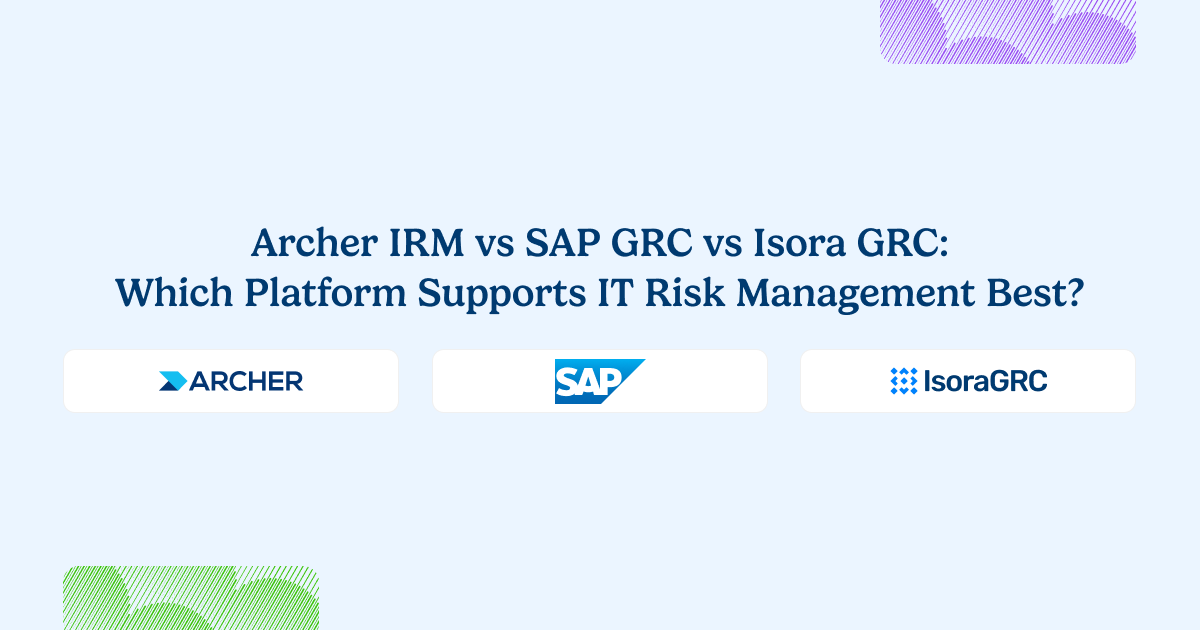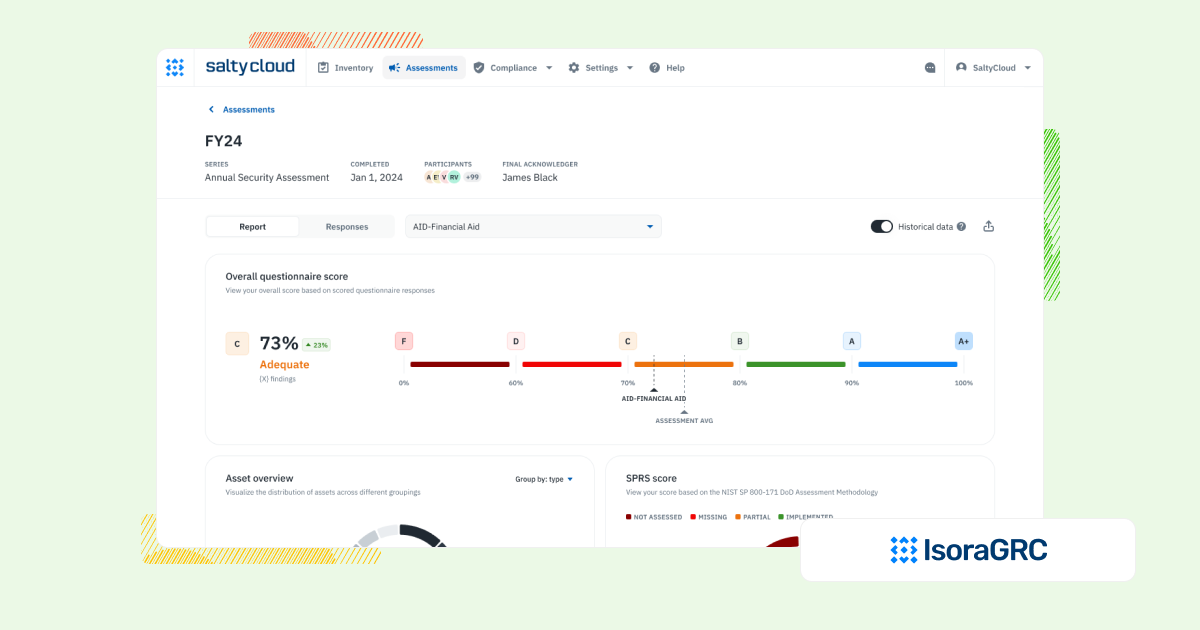
Every security team needs a streamlined, scalable way to manage IT risk without drowning in complexity.
Platforms like Archer IRM and SAP GRC offer comprehensive GRC functionality, covering everything from risk management to compliance.
But when a platform tries to do everything, security teams often end up with too much complexity and not enough clarity. These systems can be difficult to configure, slow to adopt, and disconnected from the day-to-day workflows of managing IT risk.
Isora GRC offers a focused alternative. It’s purpose-built for security teams who need to assess assets, track risks, and manage vendors, without the complexity or overwhelming scope of larger GRC platforms.
Let’s take a closer look.
Choosing the Right Platform for IT Risk Management
Archer IRM and SAP GRC are highly configurable platforms, but that configurability comes at a cost. They often require months or years to fully implement, and once deployed, they lock teams into rigid workflows that don’t match how security teams operate.
Isora GRC focuses on delivering what security and risk teams need right now: fast setup, intuitive workflows, easy stakeholder collaboration, and structured management of assessments, inventories, exceptions, and risk registers. It’s a platform built for adoption, not just configuration.
The Workflow That Matters: Managing IT Risks and Compliance
Managing IT risk isn’t a side project—it’s a continuous workflow that requires engagement from internal teams, vendors, and leadership. Security teams must assess, gather evidence, maintain inventories, document risks, and track remediation efforts—all without losing momentum.
Legacy GRC systems often slow this work down. Heavy configuration, disconnected modules, and siloed processes make it harder to manage real-world risks in real time.
Isora GRC unifies the IT risk management workflow in one place—making it easier for teams to assess risk, engage stakeholders, and maintain visibility without getting stuck in endless setup or platform maintenance.
How Each Platform Supports IT Risk Management Workflows
| Workflow Area | Archer IRM | SAP GRC | Isora GRC |
| Assessment Management | Document-driven approach with complex approval workflows. Requires specialized resources and extensive professional services to implement properly. | The tools work, but the system feels too complex. Setting up workflows takes technical skill. Without that, work slows down. | Centralized, intuitive assessment dashboard across business units, vendors, and assets. Built specifically for security teams. |
| Questionnaire Delivery & Completion | Limited questionnaire capabilities that require extensive configuration. Not designed for end-user completion, requiring technical mediators. | Survey tools feel basic and rigid. Making and managing forms takes a lot of manual work. Customizing them is tough. | Customizable and prebuilt questionnaires for frameworks like NIST, ISO, GLBA, HIPAA, and more. Designed for internal and external collaboration. |
| Inventory Tracking | Extensive asset and entity management requiring specialized setup and ongoing maintenance. Complex hierarchies that are difficult to navigate and maintain. | Tracking feels basic. Real-time updates don’t work well. Linking with other systems is limited, which hurts big teams the most. | Centralized tracking of assets, vendors, and organizational units with integration support for existing data sources. |
| Risk Register & Exception Management | Advanced risk register requiring specialized knowledge with formal signoff processes that create bottlenecks. Exception governance managed through multiple modules requiring integration. | The risk register feels too simple. Custom setups don’t work well. Exception tracking takes too much manual effort and feels clunky. | Flexible, collaborative risk register with scoring, status, evidence, and ownership tied directly to assessments. Exception management is built-in and intuitive—no extra modules or configuration required. |
| Scoring, Reporting & Risk Visualization | Powerful but complex reporting capabilities requiring significant consultant hours to set up. Difficult to modify without specialized knowledge. | Reports and scores exist but feel hard to use. Visuals need tech skill to build. Non-technical users often struggle. | Automated scorecards, risk maps, and executive-friendly reports with actionable insights—no manual config required. |
| Collaboration & User Experience | Steep learning curve with overwhelming interface. Collaboration through “Archer Engage” but lacks intuitive discussion tools. Most users need extensive training. | The design feels hard to use. Teams find it tough to work together in the system. Switching between modules causes frustration. | WCAG-compliant, award-nominated interface with built-in commenting, team workflows, and fast onboarding. |
| Implementation & Setup | Implementation typically takes months to years with specialized resources. High total cost of ownership with significant consulting and internal resource requirements. | Setup takes time, money, and people. Small teams often struggle. Custom work takes a long time and adds extra cost. | No-code setup in days or weeks. Minimal IT lift required. Designed to go live quickly across teams and vendors. |
What Sets Isora GRC Apart?

Isora GRC was purpose-built for information security teams—designed to support the real workflows behind risk and compliance, not just generate reports. While legacy GRC platforms require months of configuration and rigid processes, Isora takes a modern, scalable approach:
- Purpose-built for security and third-party risk teams
- No extra modules or cross-department bloat—just the workflows that matter.
- Easy for anyone to use
- Clean UI, no complex training, and built to drive adoption across the org.
- Streamlined for action, not just documentation
- Assessments, questionnaires, inventories, risk tracking, and reporting—all in one place.
- Fast, no-code implementation
- Go live in weeks, not quarters, with minimal IT lift.
- Scales with your program
- Whether you’re running a lean risk function or supporting a large institution, Isora grows with you—without getting in the way.
Who Each Platform Is Best For
| Platform | Who It’s For |
| Archer IRM | Large businesses, especially in finance or government that need custom tools to track risk and follow strict rules. |
| SAP GRC | Companies already deep in SAP. Helps track risk across business systems but feels old-school and hard to change. |
| Isora GRC | Security teams that need a scalable, usable IT risk management program across their organization. |
What Our Customers Say About Isora GRC
Security teams at top institutions are using Isora GRC to replace legacy tools and manual processes with intuitive workflows and actionable insight.
“Moving from manual processes to using Isora was a breath of fresh air. What used to take months is now automated, reliable, and defensible. Isora saves us significant time while delivering accurate insights that improve decision-making.”
Jessica Sandy, IT GRC Manager, The University of Chicago
“Isora has been essential in helping us meet our University of California cybersecurity requirements across a decentralized campus. Automating assessment data collection and reporting has given us clear visibility into unit-level risks, enabling us to prioritize resources effectively and address gaps with confidence.”
Allison Henry, CISO, The University of California, Berkeley
FAQs
What’s the difference between Archer IRM, SAP GRC, and Isora GRC?
Archer IRM and SAP GRC are enterprise GRC platforms built to serve multiple departments across large organizations. Isora GRC focuses specifically on IT and vendor risk workflows—offering a simpler, more agile way for security teams to manage assessments, inventories, and risks.
Are Archer IRM and SAP GRC considered all-in-one GRC platforms?
Yes. These platforms are designed to cover enterprise-wide governance, compliance, and audit needs. Their flexibility and depth often come with long implementation timelines and lower usability for non-specialist users.
Does Isora GRC replace tools like Archer or SAP GRC?
For information security and vendor risk management use cases, yes. Isora GRC enables teams to run structured assessments, track risk, and maintain inventories without relying on complex configurations or external consultants.
Which platform is best for managing IT risk across the organization?
Isora GRC is optimized for day-to-day IT and vendor risk workflows. It offers purpose-built tools for security teams, while Archer and SAP GRC may require significant customization to support similar functions.
Can Isora GRC be used alongside Archer IRM or SAP GRC?
Yes. Some organizations run Isora for operational risk management while keeping Archer or SAP GRC for legacy governance or regulatory reporting needs. Others use Isora as a full replacement for risk-specific workflows.
What should I look for in a GRC platform for IT risk management?
Choose a platform that supports assessments, inventories, exception tracking, and collaboration—without high overhead. Isora GRC delivers these capabilities in a user-friendly format designed for adoption across teams.



















 Other Relevant Content
Other Relevant Content